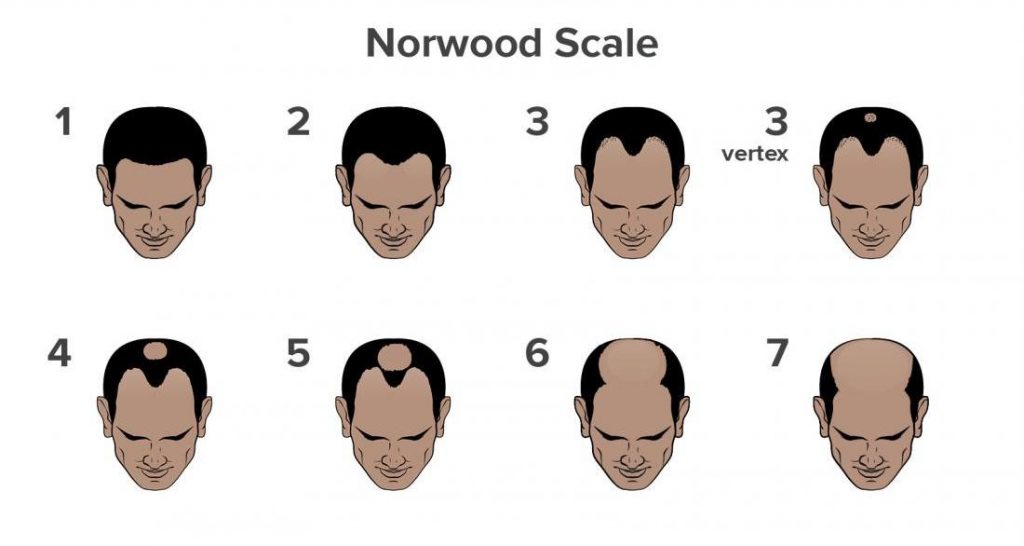Male pattern hair loss, also known as androgenetic alopecia, is the most common type of hair loss in men. In fact, about 69% of men will experience some form of male pattern baldness by the time they hit their 36th birthday.
Even with today’s advancements in science, there’s still no known cure. The good news? There are proven treatments that can combat the symptoms! Read on to learn more about the causes of hair loss
and treatment options available in Singapore.
What Male Pattern Baldness Looks Like
Male pattern hair loss typically follows a distinct pattern, often referred to as the Norwood scale.
- It usually starts with thinning of the hair on your scalp.
- It then evolves into a bald spot on the crown of your head and a receding hairline that resembles an “M” shape.
- If left untreated, it may eventually progress into partial or complete baldness.
Norwood Scale
The severity of male pattern baldness is often assessed using the Norwood Scale as shown below.

How Much is Too Much Hair Loss?
If you’ve noticed some strands of hair lying around your floor or clogging up your bathroom drain, don’t panic or jump to conclusions immediately! It’s completely normal for you to shed some hair every day. In fact, a normal person may shed 50 to 100 strands of hair per day, and this number varies from person to person. However, if you are losing more than 100 strands of hair per day or 700 strands per week, you may want to get it checked out.
Causes of Male Pattern Baldness
The primary cause of male pattern hair loss is believed to be a combination of genetic and hormonal factors.
Genetics
Male pattern hair loss can be hereditary, and it can be inherited from either of your parents. Besides deciding your likelihood of having male pattern baldness, your family history also decides how severe your hair loss is.
Hormones
Dihydrotestosterone (DHT) is a male sex hormone that is usually responsible for male sex characteristics, such as the development of the male genitals, deepening of your voice, and growth of body hair. Simply put, DHT contributes to every male’s development during puberty.
However, too much of anything isn’t going to do you any good. Excessive DHT can shrink your hair follicles, making them less conducive for supporting healthy hair growth. Furthermore, DHT messes with your hair growth cycle. Not only does this cause your hair to fall out faster, but it also causes new growing hair to be thinner and more brittle.
Treatments for Androgenetic Alopecia
Androgenetic alopecia is treatable and most treatment options work best when the hair loss is in its earliest stages.
There are two safe and effective formulas — minoxidil and finasteride — that are FDA-approved for preventing hair loss. Depending on whether you have a receding hairline, balding at the crown, or overall hair loss, your provider may recommend one or both of these treatments. If you’re susceptible to dandruff, your doctor may also recommend a shampoo which can also help as a hair loss treatment.
Minoxidil (generic Rogaine®)
Minoxidil is a FDA-approved topical solution that slows hair loss and promotes regrowth at the top of your head and crown. Increases hair growth by up to 35% according to clinical studies.
Finasteride (generic Propecia®)
Finasteride is a daily prescription-only pill FDA-approved to prevent hair loss and boost regrowth across the entirety of your head, including receding hairlines. It works by reducing the level of DHT hormones, which is the main cause of male pattern baldness. 90% effective at treating hair loss according to clinical studies.
Ketoconazole 2% Shampoo
Ketoconazole is a FDA-approved prescription shampoo that is used to treat dandruff, itchiness, and flaking. It supports healthy hair growth by reducing scalp inflammation
A combination of minoxidil and finasteride
A 2015 research revealed that using a combination of both minoxidil and finasteride is more effective than using either one alone. If you are unsure about your treatment options, don’t hesitate to connect with our doctors.
Where To Get Hair Loss Medication (Finasteride, Minoxidil) In Singapore?
The only (safest and legal) way to get prescribed medication for hair loss in Singapore is by consulting a Singapore-licensed doctor at a local GP clinic, a private clinic or an aesthetic clinic.
Singapore Telemedicine Service for Male Pattern Hair Loss
Sometimes hair loss can be a symptom of a more serious illness or nutritional deficiency. That’s one of the reasons why it’s so important to talk to a licensed physician about any significant shedding.
With Siena, a MOH-approved digital health clinic in Singapore, you’ll be able to get the hair loss medication you need from the comfort and privacy of your home.
Getting started with Siena couldn’t be simpler – all you have to do is answer an online medication evaluation to book a tele-consultation session with a licensed doctor at your convenience. If prescribed, your medication will be delivered discreetly, at no additional cost.
References
- Ho, C. H. (2021, May 5). Androgenetic Alopecia. StatPearls [Internet]. https://www.ncbi.nlm.nih.gov/books/NBK430924/.
- Tang, P. H., Chia, H. P., Cheong, L. L., & Koh, D. (2000). A Community Study of Male Androgenetic Alopecia in Bishan, Singapore. Singapore Medical Journal 2000, 41(5), 202–205.
- British Association of Dermatologists. (2019). Male Pattern Hair Loss (Androgenetic Alopecia).
- Chandrashekar, B. S., Nandhini, T., Vasanth, V., Sriram, R., & Navale, S. (2015). Topical minoxidil fortified with finasteride: An account of maintenance of hair density after replacing oral finasteride. Indian Dermatology Online Journal, 6(1), 17–20. https://doi.org/10.4103/2229-5178.148925.
